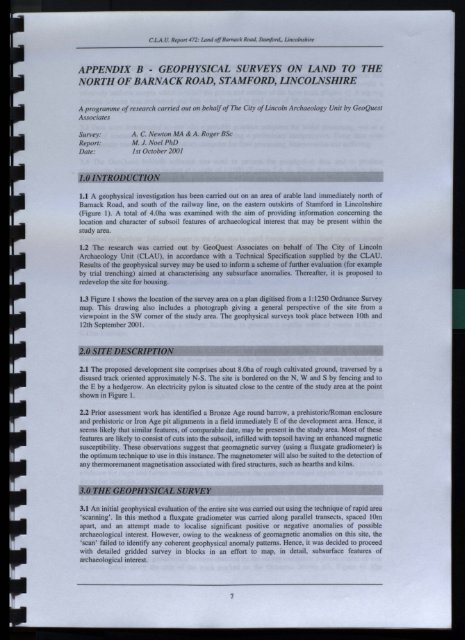land off barnack road, stamford, lincolnshire - Archaeology Data ...
land off barnack road, stamford, lincolnshire - Archaeology Data ...
land off barnack road, stamford, lincolnshire - Archaeology Data ...
You also want an ePaper? Increase the reach of your titles
YUMPU automatically turns print PDFs into web optimized ePapers that Google loves.
C.LA.U. Report 472: Land <strong>off</strong> Barnack Road, Stamford,, Lincolnshire<br />
APPENDIX B - GEOPHYSICAL SURVEYS ON LAND TO THE<br />
NORTH OF BARNACK ROAD, STAMFORD, LINCOLNSHIRE<br />
A programme of research carried out on behalf of The City of Lincoln <strong>Archaeology</strong> Unit by GeoQuest<br />
Associates<br />
Survey: A. C. Newton MA & A. Roger BSc<br />
Report: M. J. Noel PhD<br />
Date: 1st October 2001<br />
1.0 INTRODUCTION<br />
1.1 A geophysical investigation has been carried out on an area of arable <strong>land</strong> immediately north of<br />
Barnack Road, and south of the railway line, on the eastern outskirts of Stamford in Lincolnshire<br />
(Figure 1). A total of 4.0ha was examined with the aim of providing information concerning the<br />
location and character of subsoil features of archaeological interest that may be present within the<br />
study area.<br />
1.2 The research was carried out by GeoQuest Associates on behalf of The City of Lincoln<br />
<strong>Archaeology</strong> Unit (CLAU), in accordance with a Technical Specification supplied by the CLAU.<br />
Results of the geophysical survey may be used to inform a scheme of further evaluation (for example<br />
by trial trenching) aimed at characterising any subsurface anomalies. Thereafter, it is proposed to<br />
redevelop the site for housing.<br />
1.3 Figure 1 shows the location of the survey area on a plan digitised from a 1:1250 Ordnance Survey<br />
map. This drawing also includes a photograph giving a general perspective of the site from a<br />
viewpoint in the SW corner of the study area. The geophysical surveys took place between 10th and<br />
12th September 2001.<br />
2.0 SITE DESCRIPTION<br />
2.1 The proposed development site comprises about 8.0ha of rough cultivated ground, traversed by a<br />
disused track oriented approximately N-S. The site is bordered on the N, W and S by fencing and to<br />
the E by a hedgerow. An electricity pylon is situated close to the centre of the study area at the point<br />
shown in Figure 1.<br />
2.2 Prior assessment work has identified a Bronze Age round barrow, a prehistoric/Roman enclosure<br />
and prehistoric or Iron Age pit alignments in a field immediately E of the development area. Hence, it<br />
seems likely that similar features, of comparable date, may be present in the study area. Most of these<br />
features are likely to consist of cuts into the subsoil, infilled with topsoil having an enhanced magnetic<br />
susceptibility. These observations suggest that geomagnetic survey (using a fluxgate gradiometer) is<br />
the optimum technique to use in this instance. The magnetometer will also be suited to the detection of<br />
any thermoremanent magnetisation associated with fired structures, such as hearths and kilns.<br />
3.0 THE GEOPHYSICAL SURVEY<br />
3.1 An initial geophysical evaluation of the entire site was carried out using the technique of rapid area<br />
'scanning'. In this method a fluxgate gradiometer was carried along parallel transects, spaced 10m<br />
apart, and an attempt made to localise significant positive or negative anomalies of possible<br />
archaeological interest. However, owing to the weakness of geomagnetic anomalies on this site, the<br />
'scan' failed to identify any coherent geophysical anomaly patterns. Hence, it was decided to proceed<br />
with detailed gridded survey in blocks in an effort to map, in detail, subsurface features of<br />
archaeological interest.<br />
7

















